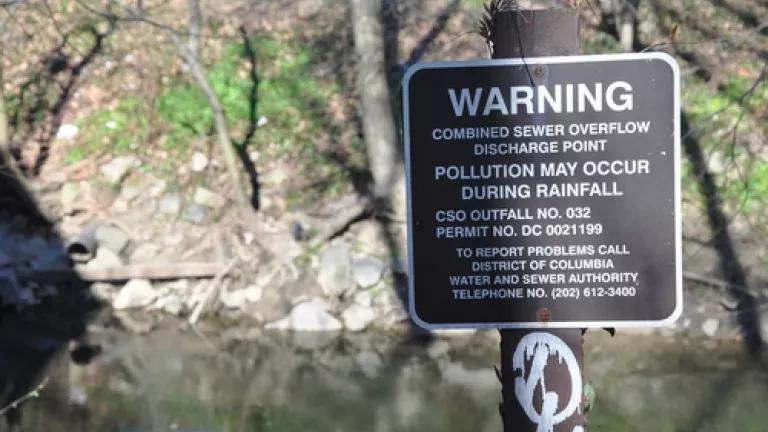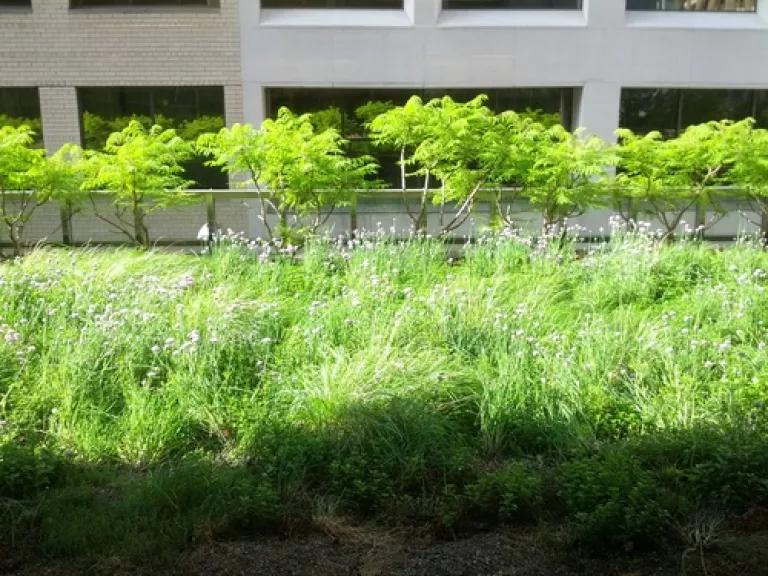DC Water Announces New Proposal to Clean Up Rivers Using Green Infrastructure Instead of Tunnels

If you're a fan of the idea of turning our nation's capital into a cleaner, greener city, you should be excited by yesterday's news from DC Water. The water and sewer utility announced that it will use green infrastructure to catch rainfall and prevent sewage overflows into the Potomac River and Rock Creek instead of building the underground tunnels it had originally planned.
In about a third of the District of Columbia, the city's decades-old (in some places, centuries-old) "combined" sewer system collects both rainfall and sewage in the same pipes. When it rains, the system becomes overwhelmed and overflows by design into local waterways. These overflows dump billions of gallons of raw untreated sewage into our rivers and streams every year, making them unsafe for swimming, boating, or other human contact.
A combined sewer overflow warning sign along Rock Creek. Photo credit: NRDC
DC Water, who operates the system, signed a legal agreement in 2005 to build massive underground tunnels that will store this sewage-rainwater combination until it can be sent to the District's sewage treatment plant at Blue Plains. Construction has already started on one of the tunnels, which will prevent overflows into the Anacostia River. That tunnel will go into operation in 2022.
But yesterday DC Water announced a new direction for the remainder of what it calls the "Clean Rivers Project." The Environmental Protection Agency and Department of Justice have given DC Water the thumbs up to eliminate or downsize the tunnels that were planned for the Potomac River and Rock Creek and use green infrastructure to capture rainfall instead.
Green infrastructure is a collective term for practices like green roofs, porous pavement, and rain gardens that stop rain where it falls, allowing it to filter back into the ground. That keeps it from turning into runoff that enters our combined sewer system and causes sewage to overflow during rainstorms.
Using green infrastructure to prevent combined sewer overflows is not only a cost-effective way to clean up our waters - it also provides a host of other benefits, such as increasing urban green space, helping to reduce flooding, countering the urban heat island effect, reducing air pollution, cutting heating and cooling energy costs, reducing potable water demands, generating demand for green maintenance jobs, and even creating value for residential and commercial property owners.

The rainwater-capturing green roof on NRDC's office building. Photo credit: NRDC
We're excited to see DC Water embracing green infrastructure as part of the Clean Rivers Project. In fact, NRDC petitioned DC Water to incorporate green infrastructure into its plans nearly five years ago. And we've supported the use of green infrastructure to stop sewage overflows in other cities, like Philadelphia and New York.
Implementing green practices in the neighborhoods near the Potomac and Rock Creek will create many benefits for those communities. (We would have liked to see DC Water commit to using green infrastructure in the neighborhoods along the Anacostia as well so that families in the southeast part of the city would be able to share in those benefits.)
We're also encouraged by the fact that this proposal contains objective performance metrics for the use of green infrastructure. While earlier proposals would have only required DC Water to spend a certain amount of money on green infrastructure with no guarantees of performance, the new plan directs the utility to manage the volume of runoff produced by 1.2 inches of rain falling on nearly 500 impervious acres of land that currently does not absorb stormwater.
We still need to independently evaluate these metrics to make sure they'll ensure an equivalent level of sewage overflow reduction to what the tunnels would have provided. We also need to make sure that the plan provides a clear mandate for DC Water to maintain the green infrastructure into the future, as those practices need more upkeep than underground tunnels would. So while the general direction of the proposal looks promising, the jury is still out on many of the details.
And some of the news is not good. The major downside to this proposal is that it will give DC Water more time to complete the project, leading to additional years of raw sewage entering our rivers. Although delays are reduced from earlier proposals, we're disappointed that this new plan would still give DC Water an additional five years to complete all of the projects needed to curtail overflows.
The public will soon have the opportunity to comment on this proposal. NRDC will be weighing in to advocate for DC Water to clean up our rivers - and green our city - on the fastest possible schedule.

